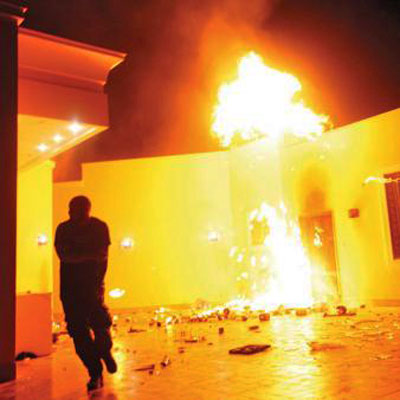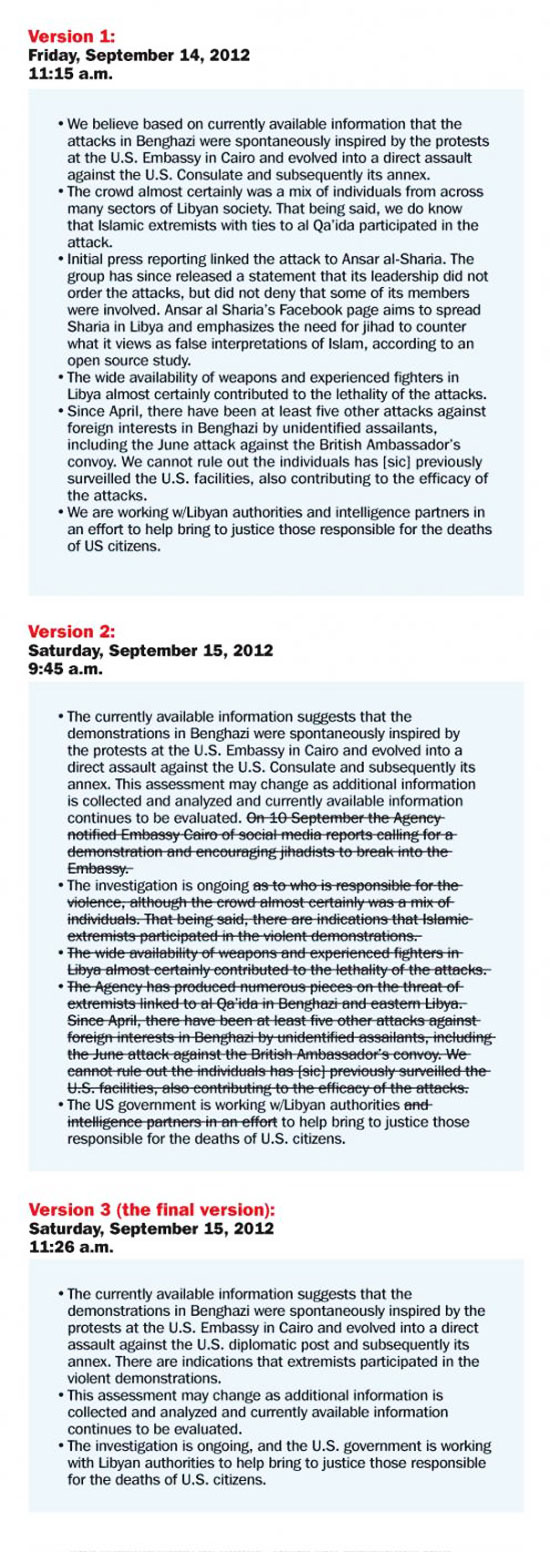|
May 13, 2013 Vol. 18, No. 33 from TheWeeklyStandard Website
Stephen F. Hayes
is a senior writer at The Weekly Standard.
The Weekly Standard has obtained a
timeline briefed by the Office of the Director of National Intelligence
detailing the heavy substantive revisions made to the CIA’s talking points,
just six weeks before the 2012 presidential election, and additional
information about why the changes were made and by whom.
The Embassy in Benghazi burns
Senior administration officials, however, sought to obscure the emerging picture and downplay the significance of attacks that killed a U.S. ambassador and three other Americans.
The frantic process that produced the changes to the talking points took place over a 24-hour period just one day before Susan Rice, U.S. ambassador to the United Nations, made her now-famous appearances on the Sunday television talk shows.
The discussions involved senior officials from,
The exchange of emails is laid out in a 43-page report from the chairmen of five committees in the House of Representatives.
Although the investigation was conducted by Republicans, leading some reporters and commentators to dismiss it, the report quotes directly from emails between top administration and intelligence officials, and it includes footnotes indicating the times the messages were sent.
In some cases, the report did not provide the
names of the senders, but The Weekly Standard has confirmed the
identities of the authors of two critical emails - one indicating the main
reason for the changes and the other announcing that the talking points
would receive their final substantive rewrite at a meeting of top
administration officials on Saturday, September 15.
The White House and committee leadership agreed to that arrangement as part of a deal that would keep Republican senators from blocking the confirmation of John Brennan, the president’s choice to run the CIA.
If the House report provides an accurate and complete depiction of the emails, it is clear that senior administration officials engaged in a wholesale rewriting of intelligence assessments about Benghazi in order to mislead the public.
The Weekly Standard sought comment from officials at the White House, the State Department, and the CIA, but received none by press time.
Within hours of the initial attack on the U.S. facility, the State Department Operations Center sent out two alerts:
According to the House report, these alerts were circulated widely inside the government, including at the highest levels.
The fighting in Benghazi continued for another several hours, so top Obama administration officials were told even as the fighting was taking place that U.S. diplomats and intelligence operatives were likely being attacked by al Qaeda-affiliated terrorists.
A cable sent the following day, September 12, by
the CIA station chief in Libya, reported that eyewitnesses confirmed the
participation of Islamic militants and made clear that U.S. facilities in
Benghazi had come under terrorist attack. It was this fact, along with
several others, that top Obama officials would work so hard to obscure.
The CIA’s Office of Terrorism Analysis prepared the first draft of a response to the congressman, which was distributed internally for comment at 11:15 a.m. on Friday, September 14 (see Version 1 far below).
This initial CIA draft included the assertion that the U.S. government,
That draft also noted that press reports,
Ansar al Sharia, the CIA draft continued, aims to spread sharia law in Libya and “emphasizes the need for jihad.”
The agency draft also raised the prospect that the facilities had been the subject of jihadist surveillance and offered a reminder that in the previous six months there had been,
After the internal distribution, CIA officials amended that draft to include more information about the jihadist threat in both Egypt and Libya.
And:
But elsewhere, CIA officials pulled back.
The reference to “Islamic extremists” no longer
specified “Islamic extremists with ties to al Qaeda,” and the initial
reference to “attacks” in Benghazi was changed to “demonstrations.”
That official, whom The Weekly Standard has confirmed was State Department spokesman Victoria Nuland, worried that members of Congress would use the talking points to criticize the State Department for,
In an attempt to address those concerns, CIA officials cut all references to Ansar al Sharia and made minor tweaks.
But in a follow-up email at 9:24 p.m., Nuland wrote that the problem remained and that her superiors - she did not say which ones - were unhappy. The changes, she wrote, did not “resolve all my issues or those of my building leadership,” and State Department leadership was contacting National Security Council officials directly.
Moments later, according to the House report,
One official - Ben Rhodes, The Weekly
Standard is told, a top adviser to President Obama on national security
and foreign policy - further advised the group that the issues would be
resolved in a meeting of top administration officials the following morning
at the White House.
But according to two officials with knowledge of the process, Mike Morrell, deputy director of the CIA, made broad changes to the draft afterwards. Morrell cut all or parts of four paragraphs of the six-paragraph talking points - 148 of its 248 words (see Version 2 above).
Gone were the reference to “Islamic extremists,” the reminders of agency warnings about al Qaeda in Libya, the reference to “jihadists” in Cairo, the mention of possible surveillance of the facility in Benghazi, and the report of five previous attacks on foreign interests.
In ensuing days, administration officials emphasized a “demonstration” in front of the U.S. facility in Benghazi and claimed that the demonstrators were provoked by a YouTube video.
The CIA had softened “attack” to
“demonstration.” But as soon became clear, there had been no
demonstration in Benghazi.
(Susan) Rice would spend much time on the Sunday talk shows pointing to this video as the trigger of the chaos in Benghazi.
There is no mention of any “video” in any of the
many drafts of the talking points.
President
Obama
and Secretary of State
Hillary Clinton even denounced the
video in a sort of diplomatic public service announcement in Pakistan. In a
speech at the United Nations on September 25, the president mentioned the
video several times in connection with Benghazi.
It was a preview of the administration’s defense of its claims on Benghazi.
After pushing the intelligence community to
revise its talking points to fit the administration’s preferred narrative,
administration officials would point fingers at the intelligence community
when parts of that narrative were shown to be misleading or simply untrue.
On September 28, a statement from ODNI seemed designed to quiet the growing furor over the administration’s explanations of Benghazi.
The statement continued:
The statement strongly implies that the information about al Qaeda-linked terrorists was new, a revision of the initial assessment.
But it wasn’t. Indeed, the original assessment stated, without qualification,
The statement from the ODNI came not from James Clapper, the director of national intelligence, but from his spokesman, Shawn Turner.
When the statement was released, current and former intelligence officials told The Weekly Standard that they found the statement itself odd and the fact that it didn’t come from Clapper stranger still.
Clapper was traveling when he was first shown a
draft of the statement to go out under his name. It is not an accident that
it didn’t.
Fox News spoke to a Special Ops soldier last week who raised new questions about what happened during the attack, and the State Department’s inspector general acknowledged that the office would be investigating the production of the Administrative Review Board report on the attacks because of concerns that investigators did not speak to a broad spectrum of individuals with knowledge of the attack and its aftermath.
On May 8, the House Oversight and Government Reform committee will hold another hearing on the matter.
And Republicans in Congress have asked the
administration to release all of the emails, something that would further
clarify how the changes came about. |


